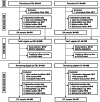Neural correlates of cognitive control deficits in pediatric mild traumatic brain injury
- PMID: 37800467
- PMCID: PMC10619369
- DOI: 10.1002/hbm.26504
Neural correlates of cognitive control deficits in pediatric mild traumatic brain injury
Abstract
There is a growing body of research showing that cerebral pathophysiological processes triggered by pediatric mild traumatic brain injury (pmTBI) may extend beyond the usual clinical recovery timeline. It is paramount to further unravel these processes, because the possible long-term cognitive effects resulting from ongoing secondary injury in the developing brain are not known. In the current fMRI study, neural processes related to cognitive control were studied in 181 patients with pmTBI at sub-acute (SA; ~1 week) and early chronic (EC; ~4 months) stages post-injury. Additionally, a group of 162 age- and sex-matched healthy controls (HC) were recruited at equivalent time points. Proactive (post-cue) and reactive (post-probe) cognitive control were examined using a multimodal attention fMRI paradigm for either congruent or incongruent stimuli. To study brain network function, the triple-network model was used, consisting of the executive and salience networks (collectively known as the cognitive control network), and the default mode network. Additionally, whole-brain voxel-wise analyses were performed. Decreased deactivation was found within the default mode network at the EC stage following pmTBI during both proactive and reactive control. Voxel-wise analyses revealed sub-acute hypoactivation of a frontal area of the cognitive control network (left pre-supplementary motor area) during proactive control, with a reversed effect at the EC stage after pmTBI. Similar effects were observed in areas outside of the triple-network during reactive control. Group differences in activation during proactive control were limited to the visual domain, whereas for reactive control findings were more pronounced during the attendance of auditory stimuli. No significant correlations were present between task-related activations and (persistent) post-concussive symptoms. In aggregate, current results show alterations in neural functioning during cognitive control in pmTBI up to 4 months post-injury, regardless of clinical recovery. We propose that subacute decreases in activity reflect a general state of hypo-excitability due to the injury, while early chronic hyperactivation represents a compensatory mechanism to prevent default mode interference and to retain cognitive control.
Keywords: BOLD; cognition; concussion; task fMRI.
© 2023 The Authors. Human Brain Mapping published by Wiley Periodicals LLC.
Conflict of interest statement
The authors declare no conflicts of interest.
Figures




Similar articles
-
Prescription of Controlled Substances: Benefits and Risks.2025 Jul 6. In: StatPearls [Internet]. Treasure Island (FL): StatPearls Publishing; 2025 Jan–. 2025 Jul 6. In: StatPearls [Internet]. Treasure Island (FL): StatPearls Publishing; 2025 Jan–. PMID: 30726003 Free Books & Documents.
-
Short-Term Memory Impairment.2024 Jun 8. In: StatPearls [Internet]. Treasure Island (FL): StatPearls Publishing; 2025 Jan–. 2024 Jun 8. In: StatPearls [Internet]. Treasure Island (FL): StatPearls Publishing; 2025 Jan–. PMID: 31424720 Free Books & Documents.
-
Interventions for preventing and ameliorating cognitive deficits in adults treated with cranial irradiation.Cochrane Database Syst Rev. 2022 Nov 25;11(11):CD011335. doi: 10.1002/14651858.CD011335.pub3. Cochrane Database Syst Rev. 2022. PMID: 36427235 Free PMC article.
-
Investigating cognitive reserve, symptom resolution and brain connectivity in mild traumatic brain injury.BMC Neurol. 2023 Dec 20;23(1):450. doi: 10.1186/s12883-023-03509-8. BMC Neurol. 2023. PMID: 38124076 Free PMC article.
-
Pharmacotherapy for chronic cognitive impairment in traumatic brain injury.Cochrane Database Syst Rev. 2015 Dec 1;2015(12):CD009221. doi: 10.1002/14651858.CD009221.pub2. Cochrane Database Syst Rev. 2015. PMID: 26624881 Free PMC article.
Cited by
-
Dynamic Functional Connectivity in Pediatric Mild Traumatic Brain Injury.Neuroimage. 2024 Jan;285:120470. doi: 10.1016/j.neuroimage.2023.120470. Epub 2023 Nov 26. Neuroimage. 2024. PMID: 38016527 Free PMC article.
-
A cautionary tale on the effects of different covariance structures in linear mixed effects modeling of fMRI data.Hum Brain Mapp. 2024 May;45(7):e26699. doi: 10.1002/hbm.26699. Hum Brain Mapp. 2024. PMID: 38726907 Free PMC article.
-
Bibliometric analysis of cognitive dysfunction after traumatic brain injury.Front Neurosci. 2025 Feb 25;19:1534735. doi: 10.3389/fnins.2025.1534735. eCollection 2025. Front Neurosci. 2025. PMID: 40071134 Free PMC article.
-
Trajectories of intrinsic connectivity one year post pediatric mild traumatic brain injury: Neural injury superimposed on neurodevelopment.Cortex. 2025 Mar;184:120-130. doi: 10.1016/j.cortex.2024.12.022. Epub 2025 Jan 13. Cortex. 2025. PMID: 39855053
-
Alterations of cerebrovascular reactivity following pediatric mild traumatic brain injury are independent of neurodevelopmental changes.J Cereb Blood Flow Metab. 2025 Jan;45(1):125-139. doi: 10.1177/0271678X241270531. Epub 2024 Aug 7. J Cereb Blood Flow Metab. 2025. PMID: 39113416 Free PMC article.
References
-
- Andersson, J. L. , Skare, S. , & Ashburner, J. (2003). How to correct susceptibility distortions in spin‐echo echo‐planar images: Application to diffusion tensor imaging. NeuroImage, 20, 870–888. - PubMed
-
- Chadwick, L. , Roth, E. , Minich, N. M. , Taylor, H. G. , Bigler, E. D. , Cohen, D. M. , Bacevice, A. , Mihalov, L. K. , Bangert, B. A. , Zumberge, N. A. , & Yeates, K. O. (2021). Cognitive outcomes in children with mild traumatic brain injury: An examination using the National Institutes of Health toolbox cognition battery. Journal of Neurotrauma, 38, 2590–2599. 10.1089/neu.2020.7513 - DOI - PMC - PubMed
Publication types
MeSH terms
Grants and funding
LinkOut - more resources
Full Text Sources
Medical

